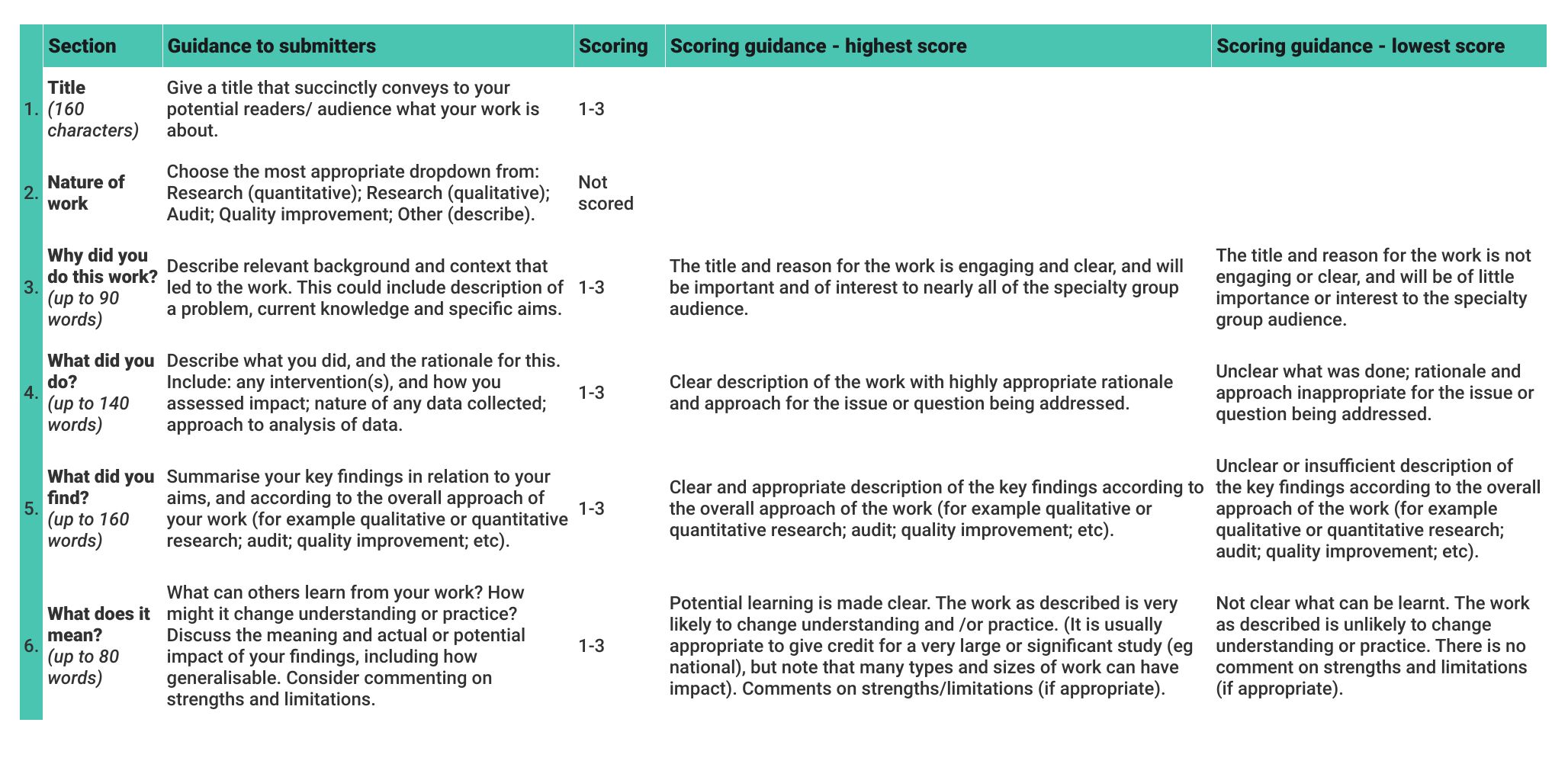Abstract guidelines
Abstract submissions are now closed.
We are no longer accepting submissions, abstracts, or abstract and author amendments.
The submission review is underway. At the end of January 2026, submitters will be notified of the outcome of their submission.

Abstract guidelines
Abstract submissions are now closed.
We are no longer accepting submissions, abstracts, or abstract and author amendments.
The submission review is underway. At the end of January 2026, submitters will be notified of the outcome of their submission.
What to consider before you submit an abstract
- Abstracts that have been previously published or presented at a conference are welcome for submission.
- Case reports/case studies/case series are permitted.
- All abstracts must adhere to the following structure: aims, methods, results and conclusions.
- You do not need to be a member of the RCS England to submit an abstract.
- We encourage relevant submissions from all healthcare professionals: trainees, residents, consultant surgeons, anaesthetists, nurses, operating department practitioners, allied health professionals, quality improvement staff and other interested hospital clinicians and staff.
Using the abstract submission system
Submitting an abstract is a multi-step process. Some questions are marked “required” and you will not be able to complete your submission until these questions have been answered. You will save your work as you proceed through the pages, however if you have to stop part way through the process your submission will not be saved or submitted and you will need to start the submission process again. After you have completed the submission, you can continue to amend your work until the submission deadline.
Amending a submission
If you wish to amend your submission you can do this at any time up to the deadline of Monday 27 October, 11.59pm (GMT).
Submission agreement
- Please do not submit multiple copies of the same abstract to different topics.
- Each person may present only one poster. If multiple posters are accepted, you must assign a co-author to present on your behalf.
- Each selected poster must be presented by a named author who must attend and be available to present the poster in person throughout both days of the conference. There is no option to present your poster virtually.
- We have a strict policy requiring the presenting author to purchase a two-day in-person ticket at the appropriate rate for that presenter according to their professional status on the first day of the event.
- Failure to register by Monday 23 March 2026, may result in your abstract being withdrawn from the conference programme.
- Registration, travel and accommodation charges are the responsibility of the presenter.
- All correspondence will initially be sent to the submitting author. This person is responsible for passing on relevant information regarding the submitted abstract and the conference to the presenting and co-authors. After the registration deadline, all correspondence will be sent to the presenting author.
- Please note the conference organisers reserve the right to withdraw submissions at any stage if they feel the content and/or organisation is no longer suitable.
Other information
You will receive an email confirmation that your submission has been received, indicating the abstract submission ID which it has been allocated. Please refer to this abstract number in all correspondence regarding the submission. Please note the email address that you supply in the submitter details page will be the email address used to correspond the results of your submission. If you change email addresses during this time, please let us know so we can update the system. Please check your junk / spam folders and contact rcseng.abstracts@wonderly.agency if you submit an abstract and do not receive confirmation that it has been received.
Queries
If you have any queries about the submission process or you want to withdraw your submission please contact us at rcseng.abstracts@wonderly.agency referencing your submission ID number. Please read the instructions below carefully before preparing your abstract:
- Aim to capture the programme committee’s interest
- Be clear and concise
- Check the abstract carefully for spelling, grammar, readability and clarity
Abstract preparation and content
Q1 Submitter contact details
Please enter the contact details of the person submitting the abstract. Please note that all initial correspondence will be with the submitter of the abstract. This cannot be changed at a later date so please do ensure that the person submitting is able to remain as the main contact throughout the submission and acceptance process. Please note that the person submitting the abstract is the only one who can view and amend the abstract in the submission system.
Q2 Title
Your suggested title should be succinct yet clearly describe the abstract. Use sentence case (i.e. the first letter of the sentence is capitalised, with the rest being lowercase except for proper nouns and acronyms). Do not use any abbreviations in the title. The titles of accepted abstracts will be published in the final conference programme and on the conference app. (Maximum 160 characters)
Q3 Conflict and declaration of interest
Please declare any potential conflicts of interest, financial or otherwise that may influence, or could be perceived to influence the content of your abstract. This includes, but is not limited to, financial relationships, affiliations, sponsorships, or personal interests related to the subject matter of your submission.
Q4 Submission declaration
Please confirm your agreement to the following statement, in order for your abstract to be considered for presentation:
“I have read and agree to follow the relevant abstract submission guidelines and will take responsibility for managing my submission. This includes acknowledging the review outcome, registering the presenting author, and preparing the required material, either a physical poster or, if selected, a physical poster and accompanying short oral presentation. I understand that to accept the invitation to present at the event, one named author must register at the appropriate two-day ticket rate (based on their professional status on the first day of the event) to present the abstract. I also accept that it is my responsibility to ensure the presenting author is not presenting more than one poster at this event.”
Q5 Preferred presentation type
The submitter will be required to indicate the preferred presentation format when submitting an abstract. The two options are physical poster only or physical poster and oralpresentation. The final decision on allocations will be made by the programme committee.
Physical posters
All accepted abstracts will be presented as A0 physical posters, displayed in person at the conference in Birmingham on both days, Monday 20 April and Tuesday 21 April 2026. Posters will be displayed in the Exhibition Hall, where authors should be available to discuss their work during the breaks.
Oral presentation and physical poster
A small number of abstracts will also be selected for a short oral presentation, in addition to being displayed as physical posters. Oral presentations will take place in the Mini Theatres located within the Exhibition Hall on either Monday 20 April or Tuesday 21 April 2026. If selected, presenters will be asked to prepare a short slide deck containing a maximum of two slides and deliver a 5-minute presentation (3 minutes to present, followed by 2 minutes for Q&A).
Please note that there is no option for oral presentation only.
Q6 Authors
Please enter the main author and any co-authors associated with this abstract. Co-authors are not mandatory, but please ensure you add all authors at the time of submission as it will not be possible to add authors at a later stage.
You will be required to enter the co-author’s details, so ensure you have these details ready:
- Title, first name, last name, organisation, job title, email address.
- You must ensure that you have gained the full consent of any co-authors and have made them aware prior to adding their details to the submission.
- Please note you can list a maximum of 10 co-authors on your submission.
Q7 Abstract submission content
Your abstract should not exceed 350 words.There is an additional 150 word allowance for references.
General style guidelines
- Use standard abbreviations only and place any unusual abbreviation in parentheses after the full word the first time it appears
- Use generic names of drugs
- If reference is made to proprietary products or equipment, the manufacturer's name and location should be included in parentheses
- Please check your abstract carefully as it cannot be amended at a later date
- Graphs, tables and images can be inserted. All images, symbols, tables, graphs and lines should be clear and distinct. Maximum file size 10MB
- You may add one table and one graph to your submission. Your submission should include a reference to the provided table and graph
The structure of your abstract
- Each section of your abstract should provide essential information about your study, allowing readers to quickly understand its scope and significance.
- We accept two types of abstracts: Research abstracts and case studies / case reports.
- Because these have different purposes, they require different structures. Please follow the guidelines below according to your submission type.
Research abstracts should be structured under the headings:
- Background: Clearly state the purpose of the abstract and why the topic is important
- Methods: Describe your selection of observations or experimental subjects clearly
- Results: Present your results in a logical sequence in text and simple tables - if results are not included, your abstract will not be considered
- Conclusion: Clearly state the conclusion of your abstract
Case studies / case reports should be structured under the headings:
- Background: Clearly state the purpose of the abstract and why the topic is important
- Case presentation: Describe the patient in detail, including history and presenting symptoms, examination findings, investigations, diagnosis, treatment or intervention, and outcome
- Discussion: Analyse the case in relation to existing literature, highlighting the significance of the findings, what makes it unique or relevant, and the key clinical considerations
- Conclusion: Clearly state the conclusion of your abstract
Review criteria
All abstracts will be reviewed ‘blind’. No identifying features such as names of authors, names of hospitals, medical schools, clinics or cities should be listed in the title or text of the abstract. Reviewers are asked to mark the abstracts on the basis of the judging criteria listed below. It is the responsibility of the person submitting the abstract to ensure that the abstract addresses the following criteria:
